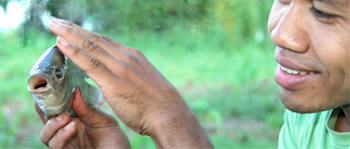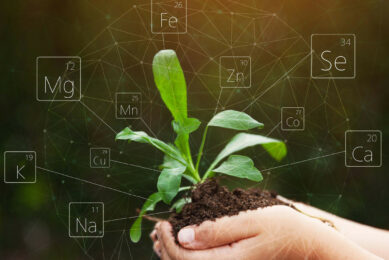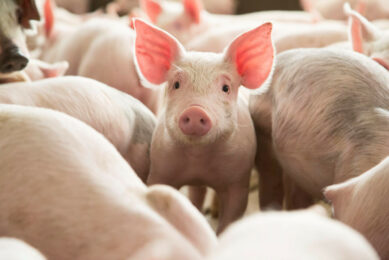Sustainable farming of the sea

A decline in the world’s fish stocks has led to an increasing demand for food from fish farming. Aquaculture is now a substantial global industry supplying a significant proportion of the fish and shellfish consumed. However, as with other forms of intensive farming there are environmental consequences.
Aquaculture production of seafood will probably remain the most rapidly increasing food production system worldwide through 2025. Being sustainable is therefore inheritably linked with the sector. A sustainable approach to the development, management and regulation of aquaculture can ensure that both the environment and industry provide long-term economic and social benefits. With respect to feeding the fish, much can be won in terms of choosing sustainable ingredients and optimising the bioavailability of the nutrients.
Sustainable feed
The main ingredients of feeds for farmed carnivorous fish species are fish meal and fish oil, at levels of about 25% and 30%, respectively. These two ingredients supply essential amino acids and fatty acids required by the fish for normal growth. More recently, small quantities of fish meal and fish oil (3-5% and 1-3%, respectively) have been included in feeds for omnivorous and herbivorous fish. Manufactured fish feeds account for 35% of the fish meal and 55% of the fish oil produced annually. Most of the rest is used in manufactured feeds for terrestrial farm animals and poultry. Carnivorous fish convert these manufactured feeds to edible flesh with maximum efficiency. Farmed salmon convert approximately 1.2 kg of feed into 1 kg of fish.
Poultry convert between 3 and 5 kg of feed into 1 kg of flesh. Pigs convert approximately 8 kg of feed into 1 kg of flesh. Fish farming is very efficient in terms of the conversion of protein, which means an important ecological advantage in light of the sustainability of fish feed resources.
One of the most-frequently cited issues with the sustainable development of aquaculture is the capture of other fish as raw material to be used as fish feed in the form of fish meal and fish oil. It is seen as an issue because a food production sector is in part relying on a capture fishery for the supply of raw materials for the production of aquaculture feed.
Typically, these other fish species are small, oil-rich, bony pelagic fish that are not normally used for direct human consumption. Two decades ago, the majority of fish meal and oil was used to make feeds for land animal production. At present, over 50% of fish meal and over 80% of fish oil is used for aquaculture. If aquaculture is to fill the gap in demand for seafood, this raises important sustainability issues regarding the availability of sufficient feed supply. This is particularly relevant given the fact that fish meal and fish oil production has been, and is likely to remain, relatively constant at around 6 million and 0.9 million tonnes per year, respectively. However, as the demand for fish meal and fish oil in aquaculture has increased, so has the price.
Replacement of marine protein sources
The depleting fish stocks have driven both terrestrial agriculture and aquaculture to seek nutritional alternatives to fish meal and fish oil. This is an on-going process and estimates made by the International Fish meal & Fish oil Organisation (IFFO) show that the growth of aquaculture and the substitution of fish meal and fish oil can continue together. Already extensive research have shown that proteins derived from grains such as corn, wheat and barley can provide the protein-rich ingredients needed in feeds for farmed salmon and trout.
Increasing ethanol production, particularly the use of corn to make the alcohol-based fuel, could be a benefit to some types of fish farming.
Plant proteins can be less costly and they are free of potential contaminants like dioxin, PCB or mercury. However, fish meal is an important ingredient in fish feed and can only to a limited extent be replaced by vegetable proteins without reducing feed efficiency and growth. After all, carnivorous or ‘piscivorous’ fish naturally feed on other fish. The fatty acid composition in the flesh from farmed fish will also reflect the feed composition and inclusion of vegetable oil will reduce the level of omega-3 fatty acids. Although the introduction of plant protein into the feed can be seen as a way of reducing the sector’s dependence on fish meal and fish oil, some have questioned the trend because: carnivorous fish do not naturally feed on plants; plant proteins may have anti-nutritional effects on fish; there is a maximum level of replacement, after which the texture and eating quality of the fish is compromised and some plant proteins could be derived from GMOs. Generally speaking, though, marine plants have enormous potential to act as fish feed ingredients. Initial research has confirmed this potential and our knowledge in this area is starting to build.
Inclusion rates of minerals
Not only the use of fish meal and fish oil is an issue, the dosages and bioavailability of nutrients in fish diets needs to be further optimised to prevent losses in the environment (when speaking about open sea cages) and to keep to prices down. Although environmental impacts associated with minerals in fish feed depend on type of production system, type of fish and type of feed, the major environmental impacts have been associated mainly with high input-high output intensive systems for carnivorous marine fish and salmonids cultured in raceways and cages. This includes the discharge of suspended solids (faeces and uneaten food), antibiotics, other drugs, disinfectants, algaecides and other compounds leached in water. Studies found elevated zinc, copper, cadmium and manganese levels in sediments under sea cages and solid wastes generated by land-based fish farms.
But simply lowering the dosages of minerals may sound too simple and may even compromise health and performance of the animals. In general carnivorous diets contain a high proportion of fish meal and marine by-products supplemented with minerals at a higher concentration than required due to limited information on their requirements and bioavailability from feed ingredients. In addition, now that fish meal is used less, and diets contain higher levels of plant protein, even more minerals are added directly to fish rations to improve growth and bone mineralisation. However, lack of knowledge on requirements and metabolism for minerals for all the different fish species that are commercially kept prevents that reliable predictions can be made regarding deficiency and toxicity levels in fish diets and more research needs to be done in this area.
Questions to be asked
If commercial aquaculture wants to grow, it has to take the sustainability issue seriously. The sector together with politicians should work on viable solutions. The following questions need to be asked: What are the current and future feed demands in the marine aquaculture sector. What percentage of fish meal and fish oil inclusion is typical in feeds, and how much can that percentage be reduced? What is the role of conventional fish meal and fish oil and alternative sources of nutrition, such as krill, algae, other microbes, terrestrial plants, by-catch, and seafood and poultry processing wastes, both now and in the future? What is the state of scientific knowledge, development, and availability of alternatives? How will market dynamics impact the transition from fish meal and fish oil to alternative proteins and oils? Furthermore, research (on feed and feed additive) needs and areas of high promise need to be identified.
*Part of the information used in this article comes from Consensus (www.euraqauculture.info)
Blue Ridge Aquaculture as role model William (Bill) Martin from Blue Ridge Aquaculture in Virginia, USA was present at the recently held Alltech International Animal Health and Nutrition Symposium in Lexington, USA. The symposium adopted the sustainability issue as its theme and therefore invited speakers with experience to give the audience an insight into how he sees the sustainable way forward for aquaculture farms. Being the largest tilapia producer in the US and the biggest indoor fish producer worldwide, Blue Ridge knows what it is talking about and can certainly be defined as a role model for the industry. Besides the fact that Blue Ridge does not use growth hormones or antibiotics of any kind, Martin further defined two pillars on which aquaculture has to focus to remain sustainable and profitable in the future. Firstly, fish feed has to become more efficient. Knowing that a 46% protein feed results in 20% protein in the waste (faecal) product of the animals, obviously concludes that much protein is lost and not used efficiently enough. Solutions should be sought in finding more different protein options and do more research on feed efficiency of different fish species. Martin said that much profit can be won here. The second important green pillar is keeping more fish indoors in controlled basins. Still many fish are kept in coast sea cages and net pens. These types of housing are getting more expensive and pose a risk to the environment as mineral rich faecal and feed waste enter the environment directly and in turn disturb the local flora and fauna. Martin said that indoor recirculation tanks can be much better controlled with posing almost no damage to the environment. He also mentioned that the size of aqua projects are getting bigger and more knowledge is being gained of breeding salt water fish (such as salmon) in tanks instead of sea cages. Blue Ridge Farm is extremely ambitious. Currently the farm is producing 4 million pounds of fish annually. The aim is to produce over 10 million pounds in the near future. When this number is reached, the farm wants to have a fully closed system, meaning that it will have its own fish feed production facilities on site. This again is a sustainable approach as no feed has to be imported bringing the carbon footprint significantly down. Martin explained that Blue Ridge Aquaculture has launched several new farms over the last few years. These are the Virginia Shrimp Farm, the West Virginia Salmon and Trout Farm and the Virginia Cobia Farm. |











